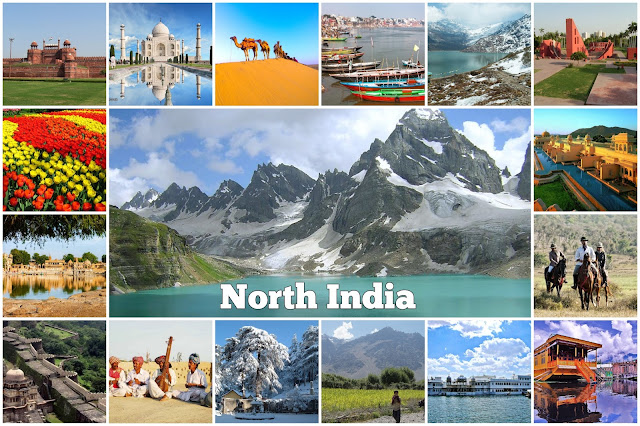With an account of massive geographical size, India has a vast range of places which offer you a unique surprise on every next step. Similarly, with a large regional differences between North and South India, everyone of us find a state of confusion that which one is preferable for our holiday. But, with the huge options, each destination has its unique charm and attractions.
If you feel yourself on the same platform of selection that which one is best? Then this writing is helpful for your decision. The final selection of holiday choice is according to your personal taste. Hopefully, this brief introduction is helpful in picking between the two. Here, you'll get the description about the climatic variations, local taste and sightseeing attractions of these two vast areas.
The North India
With the impressive range of attractions, the North zone of India has its capital location 'Delhi' along the most popular sites of Golden Triangle Tour (Delhi-Agra-Jaipur). There is a strong regional bonding between Punjab, Haryana, Jammu & Kashmir, Chandigarh, Himachal Pradesh, Uttar Pradesh and Uttarakhand with some variations on the basics of customs, rituals and traditions. Overall such varieties offer an attractive look to this region which is renowned as a prideful part of the country. With the famous landmarks, scenic Himalayan region, remote location of Ladakh, you can also explore the traditions and cultures of Rajasthan, Bihar and Madhya Pradesh like surroundings states.
The South India
In South Indian states (Andhra Pradesh, Karnataka, Kerala, Tamil Nadu, Telangana), there is the beautiful gentle pace of life with some wonderful beach attractions. If we go through the search of some relaxing holiday list, then Hyderabad, Bangalore, Chennai, Coimbatore and Kochi are in the list of largest Urban areas. There are several factors like South Indian food, classical music & dance, Kalaripayattu (ancient martial arts) and Ayurveda which work as a highlight for this region. Overall, this part of the country comprises of amazing wildlife, forested valleys, mountains and mind-blowing historical architecture. With the range of Hindu pilgrims, you can witness the point of Land's End during your visit at Kanyakumari.
Religious sites of North India
Varanasi, Bodh Gaya, Sarnath, Allahabad, Ayodhya, Shravasti, Badrinath, Kedarnath, Gangotri, Golden Temple, Devprayag, Somnath, Hemkund Sahib, Rishikesh, Mathura & Vrindavan, Amarnath Cave, Vaishno Devi, Leh monasteries, famous Churches, Gurdwaras and ISKCON temples.
Religious sites of South India
Bhubaneswar, Mahabalipuram, Kanyakumari, Kanchipuram, Rameshwaram, Madurai, Thanjavur, Konark, Chidambaram, Puri, Shirdi, Tirupati, Puttaparthi and Shravanabelagola.
Srinagar, Auli, Mussoorie, Nainital, Shimla, Manali, Ladakh, Dharamsala, Palampur, Dalhousie.
Adventure & Sports in South India
Thekkady, Gokarna, Kochi, Chennai, Dandeli, Yelagiri, Munnar, Coorg, Badami, Trichur, Marunthuvazh Malai, Neelimala, Chikmagalur, Kotagiri, Kudremukh, Ooty, Wayanad.
Ayurveda & Rejuvenation centres in North India
Rishikesh, Haridwar, Mathura, Varanasi, Uttarakhand, Dharamsala and Udaipur.
Ayurveda & Rejuvenation centers in South India
Bangalore, Chennai, Alleppey, Thekkady, Kochi, Calicut, Periyar, Kovalam, Kumarakom, Trivandrum, Mararikulam, Coonoor, Palakkad, Mysore.
Wildlife in North India
Dachigam National Park, Corbett National Park, Great Himalayan National Park, Dudhwa National Park, Gir National Park, Ranthambore National Park and Bandhavgarh National Park.
Wildlife in South India
Periyar Wildlife Sanctuary, Bandipur Wildlife Sanctuary, B.R. Hills, Nagarhole Wildlife Sanctuary, Chinnar Wildlife Sanctuary, Dandeli Wildlife Sanctuary, Mahavir Harina Vanasthali National Park.
Culture & Heritage of North India
Jaipur, Jodhpur, Jaisalmer, Chittorgarh, Kumbhalgarh, Bikaner, Udaipur, Pushkar, Khajuraho, Delhi, Kullu, Patan, Champaner, Lucknow, Bodh Gaya, Sanchi, and Agra.
Culture & Heritage of South India
Hyderabad, Hampi, Chennai, Thanjavur, Mysore, Cochin, Mahabalipuram, Badami, Aihole, Pattadakal, Darasuram.
Hill stations of North India
Lansdowne, Gulmarg, Sonamarg, Pahalgam, Srinagar, Khajjiar, Mcleodganj, Shimla, Chamba Valley, Leh, Patnitop, Kullu, Manali, Auli, Chamba, Almora, Kausani, Mussoorie, Aru, Dah & Hanu, Pithoragarh, Ranikhet, Nainital, Chail, Dharamsala, Dalhousie, Kinnaur, Mukteshwar, Kasauli, Kufri, Palampur, Keylong, Kardang, Dharamkot, Dehradun and Dhankar.
Hill stations of South India
Munnar, Ooty, Idukki, Kodaikanal, Coorg, Coonoor, Devikulam, Kerala Backwaters, Varkala, Yercaud, Nandi Hills, Ananthagiri Hills, Ponmudi, Araku Valley, Kudremukh, kotagiri, Vythiri, Kodaikanal, Wayanad, Chikhaldara, Horsley Hills, Ponmudi, Araku Valley.
Climatic Variations between North & South India
Climate conditions are more pleasant in North India in comparison to the South. South India is in the tropical zone while North is in subtropical and bordered within the temperate zone. According to latitude distance, no ocean and proximity of Himalayas offer a cooler climate to Northern region. Similarly, such logical reasons make a difference in diet from wheat to rice and higher to lower spice content in food.
Taste differences between North & South India
In India taste varies from state to state under the different categories not only in taste but also in unique cooking methods. With the several ages and cultures, Indian taste has also been influenced by different civilizations. Each dish has basic taste due to use of different spices which has the relation with medicinal and nutritional properties.
North India:
While tasting the North Indian cuisines, you'll feel a rich delight and appetizing aroma due to the use of high proportion of dairy products. In the combination of such rich gravies, you are served with 'tawa' (griddle) baking breads (roti or prantha) and 'tandoor' (coal -fired oven) baking breads (kulcha, naan & khakhra) and other deep fried breads (puri or bahtoora). North Indian royal treatment is incomplete without sweets and snacks. You can also taste a good range of non-vegetarian food here.
South India:
South Indian cuisine has majorly offers you the taste of tamarind, tomatoes, coconut and curry leaves in a variety of dishes. Basically, there is greater emphasis on staple grain- rice along the combination of sambar and rasam in a form of complete meal. The typical South Indian snacks (dosa, vada, idli, bajji & bonda) are nutritious and good for digestion. South Indians use more vegetarian-friendly food as compared to North Indians. There are a huge variety of distinct tastes with the long menu of Andhra, Chettinad, Hyderabadi Nawabi, Mangalorean, Coastal (seafood) and Kerala cuisines.































0 comments :
Post a Comment